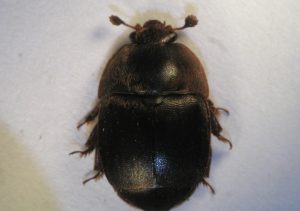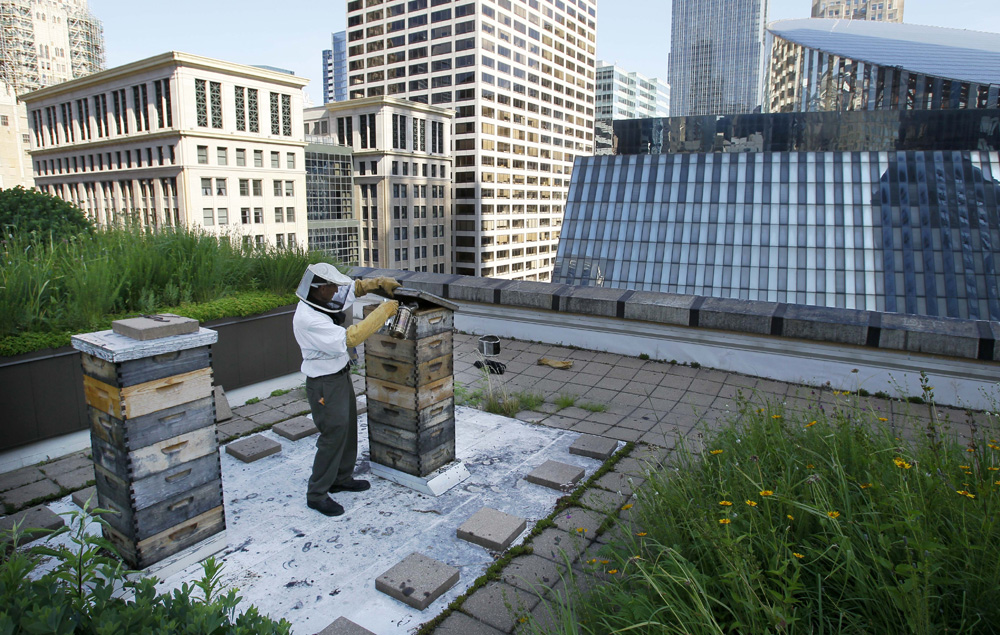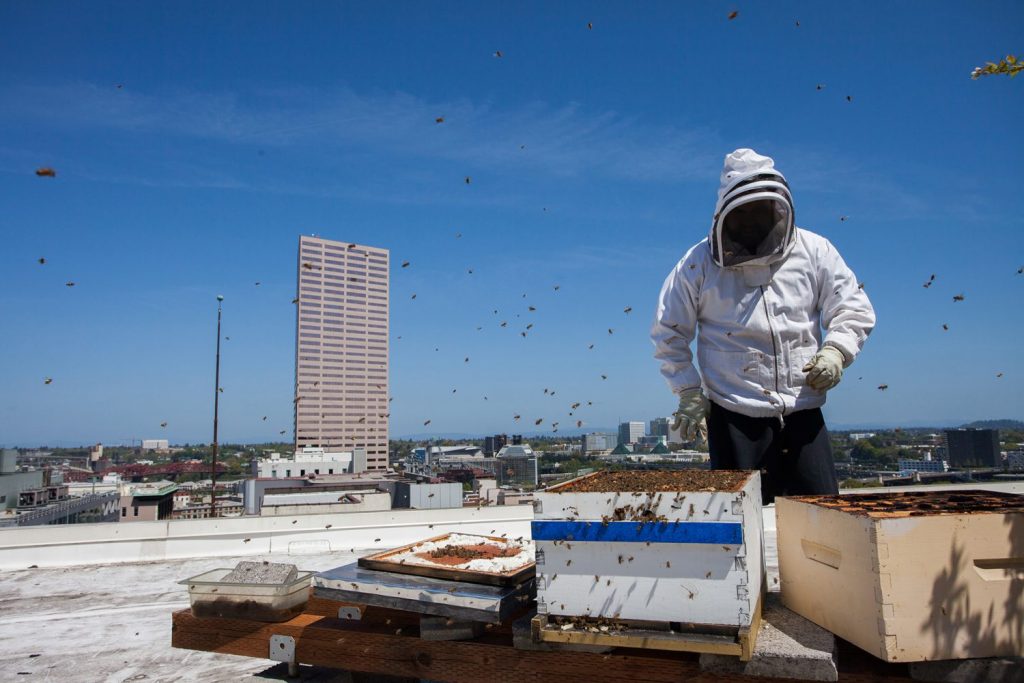If you purchase an independently reviewed item through our site, we earn an affiliate commission. Read our affiliate disclosure.
Perhaps you’ve found it a bit confusing where best to keep bees, especially if you are living in the city or in any other urban area. There is always the misconception that beekeeping is reserved for those in rural areas and that keeping bees in urban areas is not possible. However, contrary to popular belief, it is, and urban rooftop beekeeping can be just as thriving as backyard beekeeping.
The keeping of honeybee colonies in areas that are urban is done as a hobby or as a business operation. In the past, many towns and cities had prohibitions against beekeeping in urban areas. However, many cities and towns have now overturned those prohibitions over time to allow beekeeping. The inclusion of beekeeping in the local food movement helped with the eventual overturn of these prohibitions. It saw the popularity of urban beekeeping rise and the clamor for the legalization of urban beekeeping. The beekeepers in many urban areas are expected to register or at least inform city authorities that they have bees in the town. Honey produced from urban beekeeping operations is commonly sold to local shops and restaurants.
Tips to Get Started with Urban Rooftop Beekeeping
Whether you want to keep bees in an urban setting as a hobbyist, or as an investment for profit, you will still need to follow these tips below to get started with urban beekeeping:
Acquaint yourself with the laws that govern beekeeping in your urban locality
Different cities or urban areas have different laws that govern beekeeping, and while there are those that outright forbid it, some allow it as long as the beekeeper follows laid-out rules. For this reason, it will be important that you first check with your local authorities and ask them what the law says about beekeeping. If you find out that it is legal to keep bees in your local urban place, then you can then go ahead with your endeavour. Most cities have legalized urban beekeeping anyway, so you are not likely to run into a block there. It is the regulations around beekeeping that you must make sure to comply with. In the event that you are found to be contravening some law with your urban beekeeping operation, you might be subject to being fined or having the beekeeping operation shut down.
Do some research about bees and beekeeping in general
After you have established that it is legal to keep bees in your urban locality and have decided to go ahead with your urban beekeeping endeavor, it is advisable to do some research about bees and beekeeping in general. Gaining this knowledge is the first step for you in order to be successful. Reading beekeeping books is a great way to arm you with some information about honey bees and beekeeping in general. The internet too is a great source of beekeeping knowledge from reliable websites. And luckily, BeeKeepClub has all the information you need to get up and running.
Through our resources, you will learn about the bees themselves, the different types, how to care for them, how they behave, where to buy them, the costs involved in beekeeping, the equipment that you will need, honey harvesting and so forth.
Ensure there is enough space where you plan to set up your beehive(s)
You should find an area with ample space to set up your beehive. Setting up your urban be hive in a place that is near a water source will be beneficial to the bees, as it will save them the hard task of having to travel long distances looking for water. If you do not have enough space in your backyard, you can put your bee hives on your rooftop, but ensure that temperatures there will be optimum for your bees during the summer and winter seasons.
You should ensure that the space is not easily accessed by children as the bees might sting them if they wander too close. If children access the urban beekeeping area, they must be under supervision. You may teach the children about beekeeping as you practice your urban beekeeping. It gives them practical life skills and makes them attentive to the need for caution around beehives. The area should also be one that receives enough sunlight and is not exposed to strong winds and possible bee predators.
Talk to your neighbors about your beekeeping plans
Telling your immediate neighbors about your beekeeping plans at your place is a wise thing to do. You can do so by explaining to them how you will keep your bees safe, and ensure their safety and that of their children. Most people are usually scared of bees for fear of the fact that they may sometimes sting. You can allay such fears by talking to them about the various safety steps you have taken that will guarantee their safety from your bees.
Get all the necessary beekeeping equipment that you will need
Before you purchase your bees, it is important to have all the necessary beekeeping equipment such as the beehive, the beekeeper’s suit, the bee smoker etc. ready and waiting. Urban beekeeping works best if you have everything you need in place before making a purchase of bees. For beginner beekeepers, a beekeeping starter kit is a safe way to go. You can buy one with the guidance of a beekeeping mentor and then add the other necessary equipment that may not be included in the beekeeping starter kit.
The Pros of Urban Rooftop Beekeeping
It helps to boost the income of the beekeeper
As you know, urban dwellers are often faced with numerous financial needs which include utility bills, high rent payments, the cost of commuting to and from work and so forth. Beekeeping for economical reasons in your local urban area, can help supplement your bills when the honey is harvested and sold for a profit. You can also go into the production of other beehive products such as pollen, propolis, royal jelly and beeswax in addition to the honey you harvest. Once you are an established beekeeper, you can also split hives and sell off the splits to beekeepers that are starting new beehives.
Urban bees are resilient and healthy
Scientific studies have shown that bees that are kept in urban areas are usually stronger and healthier compared to those in rural areas. The study found that it is the diet of the urban bees that make them stronger compared to those found in rural brethren. The explanation behind this is the fact that various species of flowers have pollen that has a different collection of nutrients which gives numerous health benefits to the bees. In urban areas, there is usually a higher diversity of pollen than in rural areas. Additionally, the number of plants of each species in urban areas is not usually too high to allow honey bees to collect nectar and pollen from only one plant species.
High-quality honey
The honey produced in urban beekeeping is of quite high quality when it does not contain contaminants. In rural settings, there is less variety of vegetation than in urban areas. Even where there is variety, the abundance of a single type of plant as often found in rural areas often causes bees to make honey from the nectar of largely one plant species. A greater variety of plant species in urban areas makes bees colleen different types of nectar and pollen. The nectar of varying compositions makes urban beekeeping honey very sweet and nutritious.
Contribution to bee conservation
Urban beekeeping helps contribute to honey bee conservation efforts around the world. The populations of urban bees can swarm and turn into wild honey bees that provide genetic stock in the wild. Swarming honey bees are often trapped and used by beekeepers to improve the genetics of their existing honey bee colonies. They can also be added to beehives to strengthen failing hives. Honey bee conservation needs have made a lot of people who are aware of the need to take up hobbyist beekeeping. They allow their honey bees to swarm frequently in an attempt to increase the number of bees in the wild.
The Cons of Urban Rooftop Beekeeping
Limited green spaces in cities cause low honey yields
As more people take to urban beekeeping, the competition for resources between honey bee colonies increases. Since the space covered by vegetation in the city remains quite constant, each honey bee colony ends up with less honey produced per year. It slows the growth of individual urban honey bee colonies and affects the foraging power of the honey bee colonies. This phenomenon has been noted in New York City and in London too. When the problem is too much, the urban beekeeper incurs losses and may have to resort to feeding the honey bees in their urban beekeeping operation.
Urban environments are great incubators of honey bee diseases
A study carried out in 2015 found that urban beekeeping has conditions that tend to promote the existence and transmission of honey bee diseases. The urban bees become reservoirs of the diseases which can then be frequently transmitted to rural beekeeping operations. Generally, this makes urban beekeeping expensive for the beekeeper because they have to deploy treatments for diseases more frequently than their rural beekeeping counterpart.
A high number of bees in urban areas and shortages of forage cause frequent swarming of honey bees
This phenomenon has been noted even in bees that are not normally predisposed towards swarming. This affects the strength of colonies and many face a shortage of honey reserves in winter. If the urban beekeeper does not feed such a colony, it is likely to die off in winter. In the end, an urban beekeeping operation faced with this problem turns expensive for the beekeeper. When the honey bee colony does not swarm away, it might resort to robbing nearby beehives. Honey bee colony robbing is a frequent occurrence in urban beekeeping where there are limited nectar sources. Robbing behavior in urban honey bees results in the fast spread of diseases and parasites.
Urban environments are sometimes not very clean
Honeybees may pick up some contaminants from the environment. The contaminants will then be found in honey produced by those bees. Along the same line, sweets and candy manufacturers found in urban environments have reported bees collecting the syrups used to make candy instead of nectar. Beekeepers too have at various times found the honey produced and stored by their honey bees to be made from artificial sugars gathered from urban landscapes. The honey even has different colors from regular honey such as blue, green and red! Such honey from urban beekeeping operations cannot be sold in the market, therefore the beekeeper suffers a loss.
How Urban Rooftop Beekeeping is Done
On Rooftops
Keeping bees in urban areas is practiced in nearly the same way rural beekeeping is done. It varies in that the rooftops are the common choice locations for beehives. Any rooftop from one story to 4 stories can be used for beekeeping. Some go higher with one beekeeper reportedly keeping bees on his 14th-floor rooftop! The reason that rooftops are loved for the location of beehives is that they allow bees to fly to and from the beehive without contact with people. It saves the beekeeper the cost of putting up a fence or barrier, as would be necessary were the beehives located on ground level.
At the rooftops, some industrious urban beekeepers practice rooftop agriculture of flowering plants to give their honeybee colonies some supply of nectar and pollen. The plants may be food crops or not, since the primary reason they are grown is for their nectar and pollen production capabilities.
Using Langstroth Beehives
The Langstroth beehive is loved in the USA, and in urban beekeeping too. It is the most widely used beehive type because of its vertical expandability. Urban beekeeping on rooftops makes it easier to set up the beehives and ensure they are dry. Invented around 1850, Langstroth beehives have standard measurements and movable frames. The beehive makes use of bee space that sees honey bees draw comb on frames without attaching the frame to the sides or to other frames. This makes hive management and extraction of honey easy for the beekeeper. Just as in rural beekeeping, the Langstroth beehives in urban beekeeping benefit from a coat of paint or preservative on the outside. It adds life to the beehive even when it is exposed to the elements.
Using Safety Equipment
Urban beekeepers use safety equipment such as beekeeping suits and bee smokers to prevent bees from stinging them when working their hives. The best beekeeping suits are made from strong fabric that does not allow bee stings through. Smokers are used to blow puffs of smoke on the bees so they take to gorging on honey. It keeps them occupied so they do not sting the beekeeper. These safety measures are important and required for all beekeepers in urban settings. Without adequate safety precautions taken, beekeeping would be a painful experience that people would not engage in. Bee stings in large numbers can also turn life-threatening.
When going on a hive inspection, it is recommended that you remove watches and other jewelry that creates zones of light and contrasting dark areas. Bees can also get aggravated or excited by strongly scented perfumes. In the unfortunate event that you are stung, scrape off the sting instead of pulling it out. The attempt to pull it out can result in more of the bee sting irritant being released into the skin.
Proper Beehive Placement
Siting urban beehives follows the general guidelines for beehive placement. In northern regions, the beehive entrance is recommended to be facing south. For areas closer to the equator, the hive entrance should face east. This directional recommendation for the siting of beehives makes the morning sun hit the beehive so that bees get to an early start in the day. They are able to get active for more hours of the day, thus collecting more nectar and pollen per day.
When doing urban beekeeping at ground level, try to have the flight path of your bees not intersect with human traffic. It prevents interaction between the bees and people which can result in stinging incidents. Some cities that allow urban beekeeping require you to have a fence near the beehive so that the foraging activity of honeybees starts at a high height where there are no humans. For rooftop urban beekeeping, a fence is not necessary.
Purchasing Bees
Acquiring bees for urban beekeeping is done via the purchase of package bees and nuc hives. Many apiaries have nuc hives for sale to beekeepers starting new honey bee colonies. The purchase can be online or from local beekeepers. Beekeeping associations too are useful in sourcing honeybee colonies for your urban beekeeping. They link you to reliable sellers of honey bees and may even be in a position to help you with acquiring some of the beekeeping equipment you need. Nuc hives are easier to work with in installing honey bees in a new beehive. You only need to transfer the frames of the nuc hive to your new beehive and you are good to go.
The choice of honey bee species that you go for is up to you. Most urban beekeepers favor Italian bees. The species is popular in the USA and does not swarm easily. When starting a new beehive, bring the bees into the hive in early spring so they have time to settle into the hive and build up enough reserves for wintering.
Water Provision
Water is a provision you must supply for honey bees. Have a watering point for your honey bees somewhere they can easily access, but not too close to the beehive. It helps avoid clashes between bees and humans at points that bees might use as water sources. It is not uncommon finding bees that have not been given a water source, harassing people at poolsides and other places.
Harvesting Honey
Urban beekeepers can harvest honey more than once a year. A well-managed beehive and honey bee colony will produce honey from early summer to fall. During this period, harvesting of honey can be done successfully and it even helps prevent swarming. After every harvest, make sure to leave the honey bee colony enough to get them by. Especially by the end of fall, make sure the colony in your urban beehive has adequate stocks of honey to last them through winter. In winter, insulating the beehives you have in your urban beekeeping operation might be necessary. Insulation helps the bees conserve heat in the beehive so that they do not die in large numbers during winter. Strong gusts of wind should also not be allowed into the beehive in winter. A barrier or entrance closing is effective in preventing wind from entering the beehive.
Sharing Equipment and Knowledge
In urban beekeeping, some equipment is shared by beekeepers. It keeps the costs down. Equipment that is not used often such as honey extractors can be rotated between beekeepers when it is the harvest season of honey. It saves the beekeepers money they would have used buying a honey extractor for each one of them. The beekeepers come together and contribute towards the purchase of a single honey extractor that they will share. In the same manner, the beekeeping books that these urban beekeepers have are shared between them. It saves the beekeepers in a group from buying copies of the same beekeeping books. This interaction and camaraderie between urban beekeepers have resulted in stronger beekeeping clubs and a greater flow of beekeeping skills and tips from experienced beekeepers to beginner beekeepers.
Pests, Diseases and Parasites in Urban Rooftop Beekeeping
Keeping bees in urban areas comes with the common pests, parasites and diseases of honey bees. Urban beekeeping has even been found to have a higher prevalence of bee diseases than rural beekeeping. In urban areas, the beekeeper must be very vigilant and quick to treat the beehive for these pests, diseases and parasites. The close proximity to each other that is often seen in urban beekeeping operations means that diseases, pests and parasites of honey bees can spread quickly from one beehive to another, and from one apiary to another. It is not uncommon to hear of incidents where several apiaries have their honey bee colonies affected by a disease, pest or parasite that has been transmitted from one hive to many.
The major pests, diseases and parasites in urban rooftop beekeeping are:
Varroa Mites
The Varroa mite problem is on the rise in beekeeping. It has even made some authorities ban the importation of bees and beekeeping equipment that has been in contact with bees. Varroa mites are small and attach to the upper thorax of the honey bee. They are pin-head sized and brown in color. The mites suck the haemolymph of honey bees for their nutrition. They affect both the adult and pupa stages of the bees. Varroa mite control is often done in a multi-pronged approach with the utilization of chemical treatments, non-chemical treatments and mechanical measures such as using a screened bottom board. Fogging using oxalic acid is an effective method of controlling Varroa mites. It kills the mites quickly and in large numbers, and the mites cannot develop resistance to it.
Thoracic Mites
These are mites that infest honey bee colonies. They attach to the gut of honey bees near the mouth. This means that thoracic mites are internal parasites of honeybees. They are controlled by feeding honeybees patties that contain essential oils or other substances that can kill the mites.
Wax Moths

These are moths that thrive in old beehives. They are supposedly attracted to the scent of beehives. Once a wax moth enters a beehive, it lays eggs which later hatch. The larvae released from hatched wax moth eggs are the destructive agents in beehives. The larvae burrow through honeycomb in an effort to reach honey, wax and old honey bee cocoon remnants. The burrowing action and the slime they produce from their bodies cause havoc in the beehive and make the affected honeycomb unsightly.
Hive Beetles

Hive beetles are a common problem with most rural beekeeping operations but do not thrive in some urban areas. Rooftop beekeeping seen in urban areas helps curtail the development of hive beetles through their life cycle. Typically, hive beetles lay eggs in a beehive and the larvae that hatch have to pupate in the ground. In rooftop urban beekeeping, there is no soil for the larvae to burrow into. Once the larvae leave the beehive and fall onto the concrete commonly used on the rooftop, they die due to exposure or are eaten by birds. This makes the survival of successive generations of hive beetles difficult in urban beekeeping settings. However, urban beekeepers that have their beehives at ground level in an area where there is soil may have problems with hive beetles.
Foulbrood Disease

This is a disease that sees the brood of honey bees die and turn dark in color. It is caused by a bacterium. In the event that you have a foulbrood infection in your urban beekeeping operation, treat the hive with chemical treatments and dispose of the affected brood comb with extreme caution. In some jurisdictions, you are required to notify the authorities of the disease. Beehive conditions greatly affect the chances of a beehive getting infected by foulbrood disease. Too much humidity in the beehive encourages the reproduction of the causative agent of foulbrood disease, alongside many fungi that are deleterious to honey bee colonies.
Conclusion
When starting urban rooftop beekeeping, it is good to connect with other beekeepers in your area. Large cities might have more than one beekeeping club while smaller cities usually have only one. Join the club to access mentors in beekeeping. They will have urban beekeeping skills to share with you and greatly contribute to the success of your urban beekeeping operation. Urban beekeepers have neighbors in all cases. Talk to your neighbors and reassure them of their safety. The neighbors will appreciate your beekeeping since it helps them in several ways including better pollination for their backyard or rooftop gardens. Watching bees can be therapeutic as well. Sharing a little of your honey harvest with the neighbors always goes a long way in winning them over to be friendly to your urban beekeeping venture.
Notable cities in the USA that have legalized urban rooftop beekeeping and have a high number of beekeepers include: Detroit, Chicago, Milwaukee and New York. Of these, the city of New York is the one which held onto its anti-beekeeping laws the most. It however lifted the ban on urban beekeeping within the city in 2010. Around the world, Johannesburg, Toronto, Vancouver, Tokyo, Singapore, Montreal, Berlin, Hong Kong, Sydney and Melbourne have urban beekeepers. As you can easily see, these cities are spread around the world, so urban rooftop beekeeping has indeed become a global phenomenon.
 BeeKeepClub Resources and Guides for Beekeepers
BeeKeepClub Resources and Guides for Beekeepers



[…] Rooftop beekeeping is a common type of urban beekeeping, where beehives are installed on the rooftops of buildings. […]